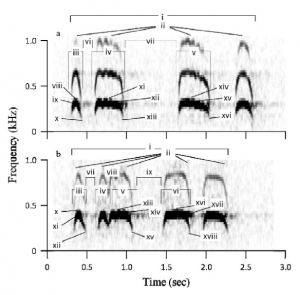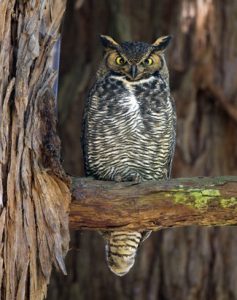Just like how we can recognize other human’s voices, we can identify individual great horned owls by their distinctive hooting. By recording these owl’s vocalizations over the years, scientists can distinguish between them by analyzing certain patterns using acoustic monitoring. The duration, tone, and frequency are factors in this research. Territorial calls will be used in this next discussion.
The two sexes can be distinguished by their territorial calls. The females vary in number of notes and total call duration, whereas the males use duration and frequency of long notes to be identified (Odom K.J., Slaght J.C., and Gutierrez R.J.: 2012). GHOWs are actually very aggressive and territorial. They are a solitary species and have rarely been seen roosting in a shared tree (except prior to breeding season). An example of their aggressiveness is that there have been cases where they have committed cannibalism (Robinson B., Davis C.: 2013)! Males and females coordinate their calls during the mating season, as shown in the following recording.
A mating pair duet (Cornell University: All About Birds).
Male calls consist of one or two short notes and three long notes. Females have two to four short notes and two to three long notes (Odom K.J., Slaght J.C., and Gutierrez R.J.: 2012). As you can see below, it is quite noticeable! Can you tell which is which? (Answer is under pic!).

Male is top, female is bottom. http://www.bioone.org.ezproxy.viu.ca/doi/pdf/10.3356/JRR-12-11.1
Shown above, the short notes occur near the beginning of the call. The references “short (S)” or “long (L)” refer to the length of the notes, and the numbers refer to which notes it is. For distinguishing males apart, researchers looked specifically at the S1-L1 and L1-L2 interval durations, max/min frequencies of L1, and also the duration of S1, L1 and L2. To identify different females apart, they looked at S2-L1 and L1-L2 interval durations, min/max frequencies of L2, how long the call was and how many notes were in it (Odom K.J., Slaght J.C., and Gutierrez R.J.: 2012).
Top recording is female, the bottom recording is male (The Owl Pages).
As I have previously mentioned, GHOWs have their own territory. Their home range can average around 2.5 square kilometres. You can hear them call from dusk to midnight, and then again around dawn (The Owl Pages). They are more abundant in heterogeneous (diverse) landscapes with higher forest cover (36%-65%) and more edge (Grossman S.R., Hannon S.J., Sánchez-Azofeifa A.: 2008). Their vocalizations are low frequency and can be heard well at a distance, even through trees (Odom K.J., Slaght J.C., and Gutierrez R.J.: 2012). If you’re in a forest and hear an owl hooting, it spooks your soul!
The biologists Odom K.J., Slaght J.C., and Gutierrez R.J. conducted an experiment and collected 5-12 calls from 7 females and 7 males. Based on the call analysis and some math (check out their article in references for the math), they could successfully identify individuals. Amongst these owls, their calls did vary amongst the different locations they resided in (they tested 12 different sites). Throughout a year, the male’s location was predicted accurately 100% of the time and the females 86% of the time (Odom K.J., Slaght J.C., and Gutierrez R.J.: 2012).
Another part to this research was how the calls may change over 5 years (2004-2009). These biologists compared the calls of each individual and found that they were mostly stable within a season and also over many years. They could in fact still tell hoo was hoo (get it? Hoo? Owls??). Interestingly though, it was more difficult to assign males to a site over time (only 60% correctly assigned). A prediction is that this is due to the turnover in territory ownership between years at certain sites. Meanwhile, the female’s locations were more stable over time (81% correctly assigned) (Odom K.J., Slaght J.C., and Gutierrez R.J.: 2012).
This method of acoustic monitoring has successfully shown that individual great horned owls can be identified using this non-invasive method. Combining this technology with knowledge of vocalization distinctiveness can help us learn more about their population dynamics, behaviour, movement and territory.
Literature Cited
1 – Odom K.J., Slaght J.C., Gutierrez R.J. 2012. Distinctiveness in the Territorial Calls of Great Horned Owls within and among Years. Journal of Raptor Research. 47(1): 21-30.
2 – Robinson B., Davis C. 2013. A Communal Roosting of the Great Horned Owl (Bubo virginianus). Journal of Raptor Research. 48(1): 88-89.
3 – Great Horned Owl (Bubo Virginianus) (Internet). [Cited 2017, October 1]. Available from: https://www.owlpages.com/owls/species.php?s=1220
4 – Grossman S.R., Hannon S.J., Sánchez-Azofeifa A. 2008. Responses of Great Horned Owls (Bubo virginianus), Barred Owls (Strix varia), and Northern Saw-whet Owls (Aegolius acadicus) to forest cover and configuration in an agricultural landscape in Alberta, Canada. Canadian Journal of Zoology. 86(10): 1165-1172. doi:10.1139/Z08-095.

You really have to hear their call in person to appreciate it!
Do you think their call implies any characteristics about their quality? I wondered if the deeper hooting was larger, more mature individuals but it’s hard to tell as they’re quite elusive.
The deeper hooting is found in males. I haven’t found anything that states that their quality of call determines their ability to find a mate. GHOWs are generally pretty dispersed and don’t seem to be “picky” when finding a mate!
Very interesting post Christina! It’s amazing that the owls hoots are unique to each individual and that they remain consistent over their lifespan. Do you know if any other species of owls are known for modifying their calls over time, intriguing researchers to investigate this in the Great Horned Owls?
Thanks Chanelle! Yes, I have read that previous research done on Eurasian Eagle Owl’s calls helped confirm the conclusion that these calls are specific to individuals. I also believe that ornithologists are looking into other species of owls as well (great grey owl, saw-whet owl etc.)!
Very interesting! Thanks Christina!
Interesting! Sounds like an interesting project to do, if there’s a decent number of owls in an area.